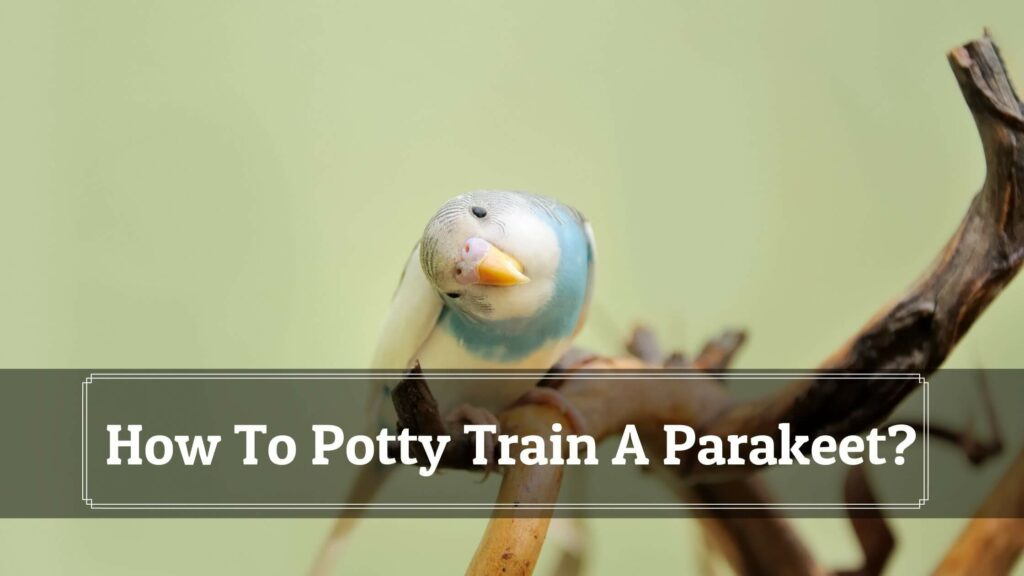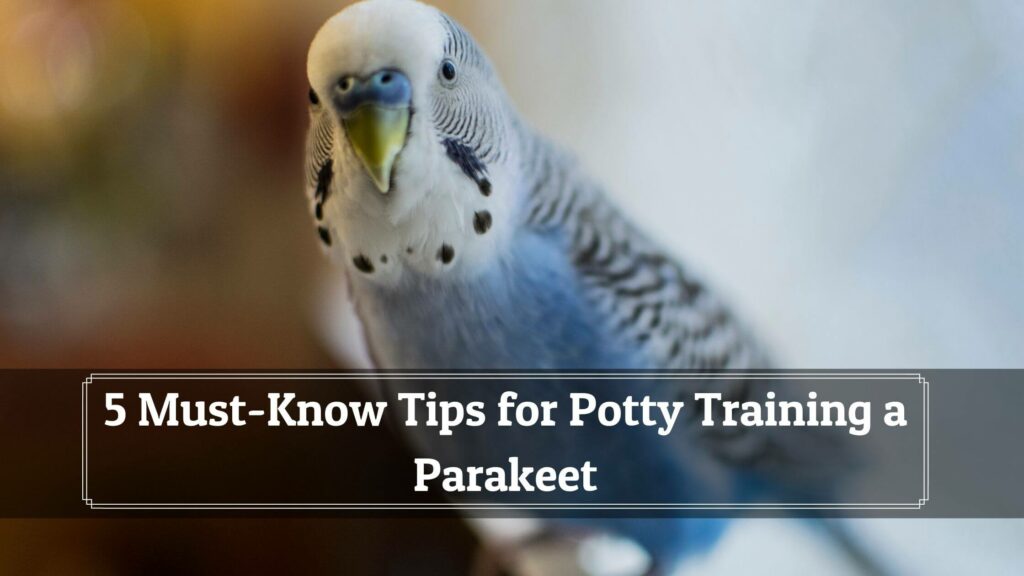
Birds like the Parakeet require some space and time away from their enclosures to stay satisfied. Parakeets also need lots of attention and love to live a long time. Insufficient care, a bad diet or even a lack of training can result in the Parakeet’s lifespan being cut down.
Your Parakeet’s favourite perch is right on your shoulder, and as a responsible owner, it is worth taking time to spend time with your bird.
It is essential to teach them correctly to reduce your workload and take the proper care of them. In this article, I’m going to assist you in learning how to potty train a parakeet.
Today, I will provide the various questions that arise when training a parakeet. If you spend some time and work hard to potty train your Parakeet, then you’ll be able to relax and enjoy having it outside the cage without having to worry about cleaning up after. First, let’s learn if parakeets can be potty-trained?
Can A Parakeet Be Potty Trained?
Despite being tiny in size, it is possible to potty train a parakeet as well. Birds with a larger size require less frequency and effort, making potty training more accessible.
However, that doesn’t mean that you can’t train your pet just because they’re small in size. While they’re small in size, their droppings can be much messier, and therefore, toilet training them is always going to help.
How Long Does It Take To Potty Train A Parakeet?
Whatever your pet’s age, they’ll learn quickly and become potty-trained quickly. In terms of how long it takes to train a parakeet to use the toilet, It varies from personality to personality and the effort of the owner.
I have observed Parakeets trained to use the bathroom and establish a hygienic habit in just 4-72 hours. It is, however, best to view potty training a parakeet as a long-term process.
How To Potty Train A Parakeet?

If you’ve determined that your pet can be potty-trained and be raised to a clean and maintained bird, it’s time to look to the specifics. The process of training a parakeet can differ from teaching them tricks or keeping them in the cage until you’re ready to let them go. This article will explain ways to potty train parakeets in five easy steps.
Step 1. Stop overreacting and creating an enormous fuss about it.
If your bird pees at all, try not to gasp or shout because it could make your bird more likely to do it to attract your attention. If you observe your Parakeet creating a mess in a suitable or safe area, you should consider cleaning the room first and then moving to the next step to train your pet for potty properly.
You have a parakeet and are teaching them to go to the bathroom isn’t a guarantee that you will not have to worry about the mess. You’ll have to clean up the Parakeet’s urine for as long as you own them.
It’s the way that animals and birds are. It’s essential to stay in the clear about what you’re signing up for the time you decide to get an animal into your house for the very first time. Cleaning them up neat is among the benefits of having an animal Bird.
- Interesting Further Reading
- Can Parakeets Tolerate Heat? If So, How Much?
- All About Parakeets Making Noise & Sounds
- Can Parakeets Live Alone? + Do Parakeets Need a Companion
- All About: Parakeets Breeding Behaviour!
Step 2. Stay focused and consistent.
The first thing to remember is that you’ll need to be consistent and vigilant to ensure the success of your education. It’s something that is always about. It’s crucial to put the Parakeet in a Poop secured area every time the need arises.
It is essential to know the signs that you Parakeets naturally pee. When moving your pet from one cage or perch to another, or taking it out of the cage, make sure you insist that he go.
Most pet birds, including parakeets, have to pee every 20-30 minutes, and occasionally it gets more frequent. As a smaller bird, If a parakeet ate, you must be sure you ask him to go toPoopp.
It’s essential to determine how often your pet’s Parakeet will go to ensure you can move to step 3. There are various signs your Parakeet may display when it’s ready to leave.
If a parakeet is ready to go, it usually shakes its back end and sits down. A few birds will be able to raise their tail feathers to serve as an alert that they’re going to pee.
It’s not difficult to recognize the signal of your parakeet when you understand the meaning behind them and what they mean. If you know the signs, relocating your pet quickly enough to be safe within the timeframe you need it is possible.
Step-3. Pick a phrase to use, and then stick to it.
To ensure that your pet understands the message you’re telling them, you must follow through with the cue words. If people use concise and straightforward phrases like”Do it now” or “Go to the toilet, they see quick results. These two words are the most effective in training potty the Parakeet.
In addition, the phrase will provide your pet with an understanding of what you’re doing and will help increase the speed of the process. Don’t reward your pet since it isn’t a good idea to make going potty an act of entertainment by rewarding.
If you begin to develop a routine of rewarding your Parakeet every time they use the safe place for them to go, this could make birds hold them for too long, causing damage to their digestive system causing various health problems.
It’s not recommended to transform your bird’s potty into a game by signalling since he might start waiting for instruction.
Step 4. Pause bonding or playtime when required.
When you have a rough idea of the duration of when your pet’s needs to go in the morning, be careful when playing with your pet on your bed or furniture.
If you observe that your pet has started to release Fales, place him perched on some paper wherever you choose to do and say the cue word. Repeat the cue and watch for him to pass. When your Parakeet is finished and is done, he will be back having a good time you spend with him.
Step 5. Resume play If interrupted or desired.
Birds, like Parakeets, love it when things happen incredibly fast within them. Avoid waiting for too long, as the time spent waiting with your Parakeet will soon disappear. If your bird’s activities or playtime are interrupted because your bird needs to go to the bathroom, be sure to get back to playing.
It’s crucial to resume whatever action you’re engaged in that was interrupted because your bird needs to in thePoopp, without transforming this necessary procedure into something that your bird can perform at your command.
- Interesting Further Reading!
- Cost Of Ownership: How Much Do Parakeet Cost?
- Why Do Parakeets Bob Up And Down?
- 7 Things You Need For A Parakeet Before Getting ’em
5 Must-Know Tips for Potty Training a Parakeet

However, even after training in the potty, a mess can happen, and that’s I will give you five ways to make these incidents insignificant and rarely feasible.
Tip 1. Create a potty-safe space and areas surrounding them.
The toilet should be inside the cage. It is best not to train your pet to pee in or in his cell. It’s essential to have multiple perches or play stands in the enclosure in which your pet can stand and use the bathroom without needing to move to a different room, area or cage. If you’ve chosen to train your pet to pee on an article of paper or in a trash bin, be sure to have one on hand.
Tip 2. Opt-out to make it easier for cleaning.
The majority of cages and perches come with a tray that can be used to collect the droppings from a parakeet. It is essential to complete the lining of the cage tray with paper, plastic or another type of bird-safe bedding for simple cleanup.
If you find your pet having poop in the wrong place, you should consider getting it cleaned as soon as possible before drying or stains begin to appear.
Tip 3. Don’t assume that a pet is a potty trained Parakeet.
Remember that, even with toilet trained parakeets, there are always accidents that will occur. Do not yell at or threaten your bird if they make a mess of your favourite furniture or cloth. Most of the time, the owner gives treats and foods to their pet more than is necessary because of affection, which can often result in a drop.
If you have any furniture or cloth around you that your Parakeet shouldn’t put on, It is best to remove him from the table or object altogether. Your pet should be allowed to play in every area where it can play and poop naturally or accidentally.
Tip 4. Make use of the same potty material.
If you’ve ever utilized a trash bin or piece of paper, or napkins, for example, in which they could go and then suddenly switch, it could make your parakeets confused. Use the same potty suitable material you used for potty-training your pet.
Tip 5. Make it enjoyable and enjoy yourself.
Being a responsible owner of a bird, You should not be too concerned about the fact that it’s faeces. When your pet has been potty trained and is potty-trained, there’s no need to get a bit silly.
If you’re watching a show and suddenly your pet has to leave into the cage, make sure you rush to the cell and give him the time to let him do his business before returning to watch the remainder of the film. It makes the entire experience more enjoyable rather than stressful.

Hi, There and Welcome to BirdsNews.com, is here to help you learn and care about pet birds. and this blog is a journal of everything I’ve learned.
